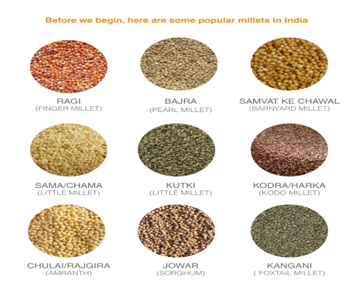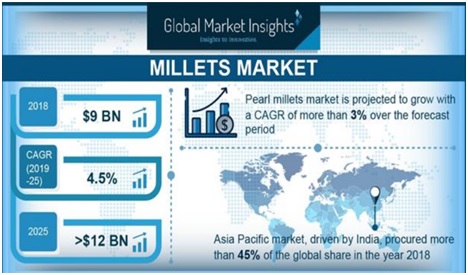‘Millet-based products set to gain increasing acceptance’
- Posted By
10Pointer
- Categories
Economy
- Published
10th Apr, 2021
-
-
Context
Recently,United Nations unanimously declared 2023 as the “International Year of Millets”. The193 membered General Assembly adopted a resolution sponsored by India and supported by over 70 nations declaring 2023 as the International Year of Millets.
-
Background
- Millet has been one of the basic sources of nutrientsfor 4 thousand years in Africa and Asia and Europe until the end of theMiddle Age.Its annual global output stands at 25 million tons.
- The area suitable for the cultivation of Milletis low-fertile land, tribal and rain-fed and mountainous areas. Haryana, Uttar Pradesh, Chhattisgarh, Gujarat, Rajasthan, Madhya Pradesh, Maharashtra, Andhra Pradesh, Karnataka, Tamil Nadu and Telangana are the states that come under such areas.
- The millets can develop from seeds to ready to harvest crops in just about 65 days. This attribute contributes to make it a better choice.
- The easy storability of millets under ordinary conditions has given them the status of Famine Reserves and this feature is of great importance for India, as the agriculture of our country suffers from the unpredictability ofthe monsoon.
-
Analysis
What are Millets?

- Millet is a type of cereal grain that had originated in Africa. It belongs to the family of These are coarse grains and contains protein, fibre, vitamins and minerals.
- They include jawar (sorghum), ragi (finger millet), Korra (foxtail millet), arke (Kodo millet),sama (little millet), bajra (pearl millet), chena/barr (proso millet) and sanwa (barnyard millet).
- Except for finger millet, all other millets need to be dehusked. Dehusked millet can be cooked like rice or can be milled to preparethe flour.
-
What are the nutritional components of millets?
- Millets are rich in vitamins A and vitamin B, calcium, iron, potassium,phosphorus, magnesium and manganese, zinc, also gluten-free and havelowGI (Glycaemic index) thus millets are suitable for people allergies/intolerance of wheat.
- The anaemia (iron deficiency), B-complex vitamin deficiency, pellagra (Niacin Deficiency-Vitamin B3) can be effectively tackled with the intake of less expensive but nutritionally rich food grains like millets.
-
What are the health benefits related to the consumption of millets?
- Regulate Blood Glucose Levels: The presence of a high amount of dietary fibre, proteins with all essential amino acids, vitamins, and minerals helps in stabilizing the blood sugar levels.
- Help in Weight Loss: Regular consumption of millet flour or having millets for breakfast can remarkably help in lowering the BMI of obese people.
- Good for Heart: Millets are loaded with antioxidants that include beta-glucans, flavonoids, anthocyanidins, tannins, lignans, and policosanols. These antioxidants play animportant role in lowering LDL cholesterol, total cholesterol.
- Battles Cancer Cells: Millets such as foxtail and proso varieties are proven by research to be effective in inhibiting the growth of cancerous cells in various tissues.
- Promotes Digestion:The presence of a good amount of dietary fibre in millets works well to improve the digestive system function.
-
What makes thecultivation of milletsenvironment friendly?
- Millets are not water or input-intensive in terms of water and fertilizers.
- Millets are found to be good at adapting to temperature changes, moisture regimes and input conditions, Millet farmers do not burden the state, demanding irrigation or power, and that makes them the ‘Future Smart Food’.
- Millets have low carbon and water footprint as compared to rice (rice plant needs at least 3 times more water to grow in comparison to millets). Paddy is a major contributor to climate change through methane emission (the greenhouse gas emanating from water-drenched rice fields).
- Millets do not require nutrient-rich soils for their survival and growth; they can even grow on skeletal soils that are less than 15 cm deep.
- They can grow well with the use of farmyard manure and household-produced bio fertilizer nutrients, so usage of synthetic fertilizers is avoided.
- They can also be termed pest-free crops since they are not attacked by pests during their growth or storage.
- All these extraordinary qualities of the millet farming system make them climate change compliant crops.
-
India’s share in millets global production and consumption:

- In India, 8 millet species (Sorghum, Pearl millet,Finger millet, Foxtail millet, Kodo millet, Proso millet, Barnyard millet and Little millet)are commonly cultivated under rainfed conditions.
- More than 55% of the global production of millets is accounted for by India, Nigeria and China.
- African countries mainly Niger, Mali,Nigeria, Burkina, and Sudan contribute more than 40% towards the global consumption of millets.
- In India, the consumption patterns of millets have taken a hit because of various reasons.The major reasons forthe decrease in consumptionare the lack of awareness of nutritional merits, inconveniencesin food preparation, lack of processing technologies.
-
What are the initiatives taken by the government?
- To boost the production of the nutrient-rich millets and the agro-industries involved in its production, India declared the year 2018 as the National Year of Millets.
- Agricultural and Processed Food Products Export Development Authority (APEDA) is preparing a perspective Action Plan for increasing export of Millet and Millet Products for a period of five years that is, 2021-2026 enabling all the stakeholders for taking necessary action in a time-bound manner.
- To promote ‘millets’, India had on its part notified millets crops as “Nutri-Cereals” and allowed its inclusion in the Public Distribution System (PDS) for improving nutritional support to the beneficiaries.
- Rainfed Area Development Programme: It deals with the development and identification of new areas receiving adequate rainfall for millet farming as a part of the Rashtriya Krishi Vikas Yojana(RKVY).
- Intensive Millets Promotion(INSIMP):The programme was launched in the year 2012 as a part of the Rashtriya Krishi Vikas Yojana for advancing equipment and technology related to millet harvest and increasing productivity of inefficient areas.
- The government had increased the minimum support price (MSP) of millets so that more and more farmers may opt for the cultivation of these less water consuming crops.
- Millets are now being a part of the mid-day meal scheme and public distribution system, for encouraging its consumption.
- The government has also initiated the ‘Integrated Cereals Development Programmes in Coarse Cereals’ under Macro Management of Agriculture.
- Millets are now being promoted under the National Food Security Mission (NFSM) to provide good nutrition to those who are unable to afford it.
-
Why is India slow in adopting millet-based products?
- The millets are seen as “poor person’s food”and it has a definite impact ontheir production and consumption.
- The government policy of disincentives towards millets and favouring of supply of fine cereals at subsidized prices makes it difficult for the millet-based product to get a market share.
- The lower or near absence of production support when compared to the support enjoyed by other commercial crops.
- Lack of appropriate post-harvest processing technologies for small millets except for finger millet.
- Competition from other market-friendly remunerative crops.
- Changes in preference patterns in consumption moving away from them mainly due to the inclusion of only rice and wheat into the Public Distribution System (PDS).
- Higher prices of millet-based products in comparison with largely consumed cereals are acting as a hindrance for penetration in the urban food market.
- In a few cases, the Organoleptic characteristicsgo against the consumption of millets. But there are viable solutions available to tackle the issue.
| Organoleptic characteristics: These are the aspects of food, water or other substances that create an individual experience via the senses—including taste, sight, smell, and touch. |
-
What would drive Millet trade?
- The growing inclination ofthe urban population towardshealthy foodand a shift towards low-calorie alternatives may stimulate the market share of millets.
- The usage of millets in infant food and nutrition products has seen a significant rise and many manufacturers are expanding their business due to its growing unexplored potential.
- The increasing unsustainable nature of rice and wheat production which are water-intensive and are likely to be unsustainable, as freshwater resources are depleting around the globe will direct the production and consumption of millets.
- They are superior to certain highly consumed cereals such as rice and wheat in terms of their nutritional values. It gives the consumers more options, thereby gives a boost to its production and trade.
- Reviving the consumption of millets using various awareness programmes across various countries is favouring the growth prospects of this product in recent years within the country and for exports as well.
- Incentivising the poor farmers to increase their crop diversity to reduce the sensitivity of rice to rainfall variability.
- Millets also help prevent many non-communicablediseases (NCD) such as diabetes, hypertension, and cardiovascular diseases.So, conscious eating habits may give a boost to its trade.
-
Conclusion
India supports 15% of the world’s population, but only has 4%of its water resources in its kitty, the promotion of millets could be helpful. “Unique characteristics of millets enable it to grow under drought-like conditions,non-irrigated conditions and even in are of low rainfall. Millets offer unique opportunities for the private sector to develop consumer-friendly, ready-to-use and low-cost food products. These products could serve the needs of the population across the spectrum, as all of us need them, either to fight malnutrition or over-nutrition. Millets also offer nutritional security to the growing population and there is a need for promoting millets as they are highly nutritious.

